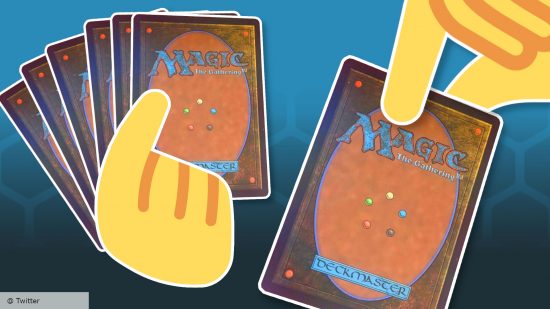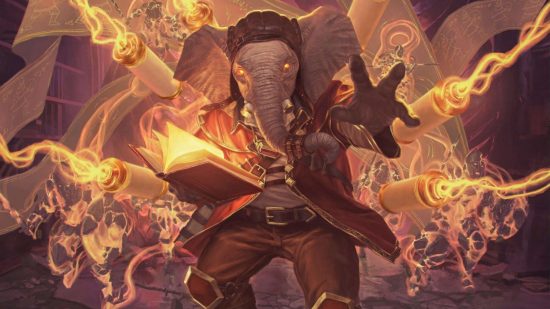To mulligan or not to mulligan? This simple decision can change the tide of your Magic: The Gathering match. The MTG Mulligan rules weren’t always part of the game, and they’ve changed plenty over the years. Given how impactful a mulligan can be, you need to stay up to date. That’s why we’ve put together this comprehensive guide to the London mulligan.
Before we begin, if you need any other rules refreshers, here’s a guide on how to play Magic: The Gathering. For the more meta-minded, we can also recommend the best MTG Arena decks in the trading card game right now.
What is an MTG Mulligan?
In short, the MTG mulligan rules allow you to draw a new hand if you don’t like your opening cards. The cost of each mulligan is that your hand gets one card smaller each time.
When players draw their opening hand in a game of Magic, each has the option to mulligan. The starting player gets to decide whether they mulligan first, followed by each other player in turn order. When everyone has decided whether or not to keep their opening hand, the mulligans can begin.
The first step of a mulligan is to shuffle your opening hand back into your deck. After that, you draw a new starting hand of the usual size (typically seven cards, but not always). Once everyone has a new hand, everyone repeats the process of declaring that they’ll keep their hand – or mulligan again.
If you like the look of your new cards, great! You can keep almost all of your hand. One card, however, must return to the bottom of your deck. Such is the price of a do-over.
You can mulligan as many times as you like at the start of a game, but your starting hand gets smaller every time you do. For example, if you mulligan three times before deciding to keep your opening hand, you must place three cards on the bottom of your library. That starting hand has gone from seven to just four cards – ouch.
Technically, you can mulligan until you have no cards left. Most people keep their hand after one, two, or maybe three mulligans, though. Once everyone has agreed to keep their current hand, the game can finally begin.
Commander Mulligan rules
Multiplayer MTG formats like Commander still use these core rules, but they allow a ‘free’ redraw on your first mulligan. By this, we mean that you don’t have to discard a card on your initial mulligan. It’s only on your second mulligan that the usual rules about returning cards to the deck apply.
MTG Commander decks are bigger than your average constructed deck, and they’ve a lot more individual cards you might want to cycle through. It makes sense, then, that the Commander mulligan rules would be a little more forgiving.
MTG Mulligan rules history
Mulligans didn’t become a staple part of Magic: The Gathering until 1994. Before that, you were expected to grin and bear your awful opening hands. No mana for the first five turns? Too bad.
The first mulligan
Enter the DCI (or the Duelists’ Convocation International). The DCI used to be responsible for enforcing rules and ensuring MTG tournaments ran smoothly.
This entity introduced the first-ever mulligan rule, which allowed players to reveal and redraw their opening hand if it contained zero or seven MTG lands. Each player could only mulligan once per game, and their second hand would still have seven cards.
The Paris mulligan
In 1997, a new mulligan rule was used at the Los Angeles Sealed Deck Pro Tour. It was later used at Pro Tour Paris that same year.
The Paris mulligan allowed a player to re-draw their opening hand for any reason, and they weren’t required to reveal anything to their opponent. The first opening hand would be shuffled back into the deck, and the player could draw a new hand that was one card smaller than the standard.
The Vancouver mulligan
The 2015 Magic Origins Pro Tour in Vancouver introduced (you guessed it) the Vancouver mulligan. This version of the rules allowed a player to re-draw their opening hand without revealing, and they would draw a hand one card smaller on their second go.
Sounds exactly like the Paris mulligan, right? The key difference with the Vancouver version is that a player can scry one card after they finish their mulligans.
The London mulligan
The London mulligan was first trialed at the 2019 London Pro Tour, and it became an official rule with the release of Core Set 2020. This form of the mulligan is still used today.
“The goal of this new ‘London’ mulligan is to make games where one or more players mulligan more competitive, especially in cases where players mulligan an unequal number of times”, wrote MTG developer Ian Duke in a 2019 blog post. “We’ve gathered data that shows that even the current Vancouver mulligan isn’t doing as good of a job as it could be in providing a competitive starting point for both players.”

Reasons to use MTG Mulligan rules
It’s pretty obvious that you should mulligan if you draw a bad opening hand. But there’s no absolute rule on what a ‘good’ or ‘bad’ hand looks like. There are a few factors to consider:
Can you play at all?
If you draw no land, you cast no spells. This is one of the most fundamental rules of Magic – and one of the most obvious cases for a mulligan. Depending on what kind of deck you’re playing, you should aim for two to five land in your opening hand. Otherwise, that’s a mulligan.
What kind of deck you’re running
Aggro decks need to hit the ground running, and they can function with a fairly small mana pool. This means you’ll want to mulligan if your opening hand doesn’t offer an immediate advantage or ways to deal damage. Aggro decks have a need for speed, but they also have the flexibility to allow for multiple mulligans.
On the other hand, Control decks take more time to wind up and need a lot more lands in play. It’s far more important to mulligan if you don’t have a good land base in your opening hand, but a Control deck can seriously suffer from a smaller starting card pool – so mulligan wisely.
If you’re playing a combo deck, you may also find yourself mulligan-ing more often to ensure you can get your deck online at a zippy pace. What’s the point of an opening hand if it doesn’t set up your winning combo?
What deck your opponent is running
You won’t always know what kind of deck you’re facing, but if you do, it can change how you feel about a mulligan. You might want to ensure your opening hand has more removal than usual, or perhaps you’re looking for ways to outpace a slower deck.
For more fun factoids, here’s a guide to every MTG set in order. We can also tell you all the latest info on MTG Arena codes.




